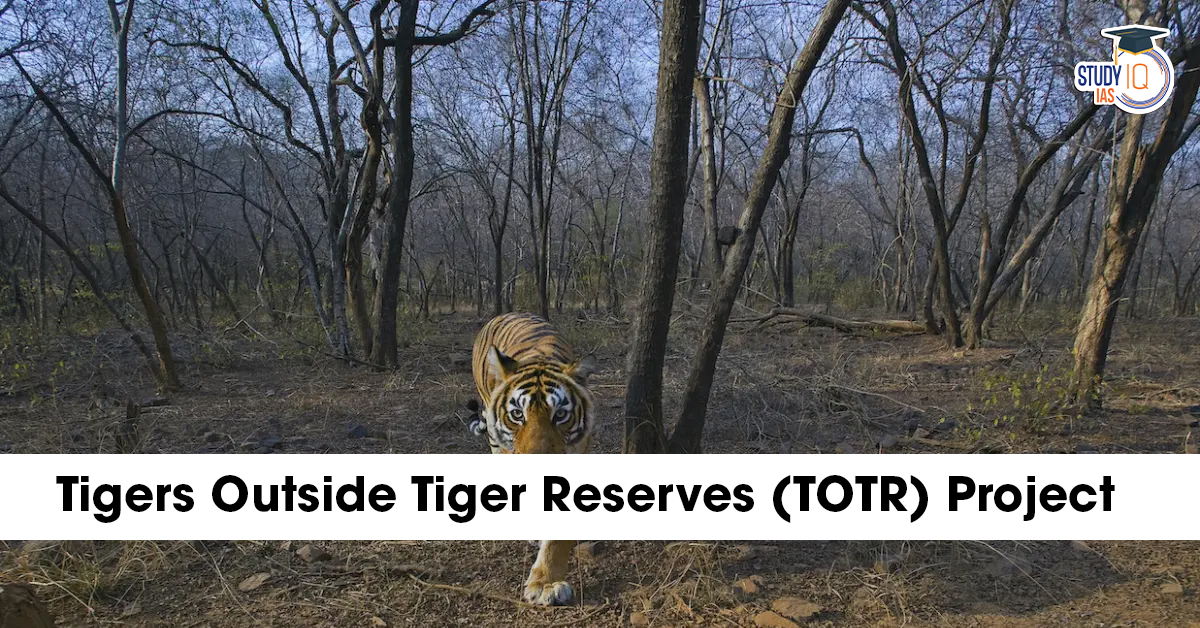Table of Contents
During Wildlife Week 2025, the Union Environment Minister launched five key conservation projects, including the Tigers Outside Tiger Reserves (TOTR) Project, along with four national-level wildlife monitoring programmes. These initiatives aim to strengthen India’s wildlife protection network and address emerging challenges in biodiversity conservation.
What is the TOTR Project?
The Tigers Outside Tiger Reserves (TOTR) Project is a national-level initiative to ensure the safety, monitoring, and management of tiger populations living outside designated tiger reserves.
It aims to reduce human-tiger conflicts, enhance wildlife protection, and promote coexistence between communities and big cats.
Objectives of the TOTR Project
-
Conservation Beyond Boundaries: Protecting Tigers Living Outside Protected Areas.
-
Conflict Reduction: Manage human-tiger interactions and prevent retaliatory killings.
-
Monitoring & Research: Track tiger movements using advanced technology.
-
Community Partnership: Promote coexistence through awareness and eco-development.
Key Features of the TOTR Project
| Component | Description |
|---|---|
| Rapid Response Teams | Deployed for immediate conflict mitigation and tiger rescue operations. |
| Use of Technology | AI-based tools, drones, GPS collars, and camera traps for tiger monitoring. |
| Real-Time Monitoring | Through the MSTrIPES app (Monitoring System for Tigers – Intensive Protection and Ecological Status) and wireless networks. |
| Capacity Building | Training for forest officials, veterinarians, and local “Bagh Mitras.” |
| Community Engagement | Awareness drives, school education programmes, and local livelihood initiatives. |
| Rescue & Rehabilitation | Equipped medical units for injured or displaced tigers. |
Implementation Structure
-
Central Coordinating Body: National Tiger Conservation Authority (NTCA)
-
Execution Agencies: State Forest Departments in coordination with local stakeholders.
-
Funding & Technical Support: Provided by the Ministry of Environment, Forest and Climate Change (MoEFCC) under the Centrally Sponsored Scheme for Tiger Conservation.
Why is TOTR Needed?
-
India = 70% of Global Tiger Population:
As of 2022, India houses 3,682 wild tigers. -
35–40% Outside Tiger Reserves:
Nearly 1,325 tigers now live in forest divisions, corridors, and fringe habitats beyond protected reserves. -
Rising Human-Tiger Conflict:
Habitat expansion leads to livestock depredation, attacks, and retaliatory killings. -
Need for Corridor Protection:
Ensuring safe movement between tiger landscapes like Sundarbans, Western Ghats, and Central India.
Other Major Conservation Projects Launched (Wildlife Week 2025)
1. Project Dolphin (Phase II)
-
Focus: Conservation of Ganga River Dolphin (Platanista gangetica gangetica) and Indus Dolphin (Platanista minor).
-
Emphasis on river habitat restoration, pollution control, and community-based ecotourism.
2. Project Sloth Bear
-
India’s first-ever national framework for sloth bear conservation.
-
Aims at habitat protection, rescue operations, and conflict mitigation in central and southern India.
3. Project Gharial
-
Seeks to revive and protect gharial populations in the Chambal and Gandak river systems.
-
Focus on breeding, reintroduction, and habitat management.
4. Centre of Excellence for Human–Wildlife Conflict Management (CoE–HWC)
-
Established at Sálim Ali Centre for Ornithology and Natural History (SACON).
-
Develops AI-based early warning systems and capacity-building modules for managing conflicts effectively.
UPSC Relevance
Prelims:
-
NTCA, MSTrIPES App, Project Tiger, Wildlife Week, CoE–HWC
Mains (GS Paper 3 – Environment):
-
Conservation of endangered species
-
Human–wildlife conflict management
-
Government initiatives for biodiversity protection
Example Question:
“Discuss the need and significance of the ‘Tigers Outside Tiger Reserves (TOTR)’ Project in the context of rising human-tiger conflicts in India.”
Conclusion
The Tigers Outside Tiger Reserves (TOTR) Project marks a significant shift from traditional protected-area-based conservation to a landscape-level approach.
By integrating technology, local participation, and rapid response mechanisms, India aims to ensure that every tiger—inside or outside reserves—remains a symbol of ecological balance and national pride.


 Commonwealth Games Host Cities (1930–2...
Commonwealth Games Host Cities (1930–2...
 G20 Summit 2025 Johannesburg: Full Outco...
G20 Summit 2025 Johannesburg: Full Outco...

























